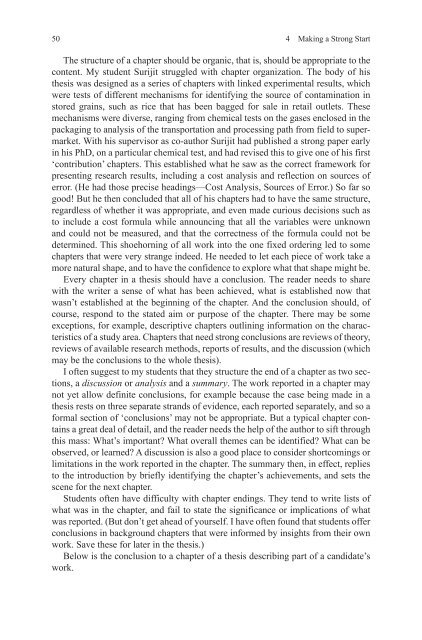How-to-Write-a-Better-Thesis
Create successful ePaper yourself
Turn your PDF publications into a flip-book with our unique Google optimized e-Paper software.
50 4 Making a Strong Start<br />
The structure of a chapter should be organic, that is, should be appropriate <strong>to</strong> the<br />
content. My student Surijit struggled with chapter organization. The body of his<br />
thesis was designed as a series of chapters with linked experimental results, which<br />
were tests of different mechanisms for identifying the source of contamination in<br />
s<strong>to</strong>red grains, such as rice that has been bagged for sale in retail outlets. These<br />
mechanisms were diverse, ranging from chemical tests on the gases enclosed in the<br />
packaging <strong>to</strong> analysis of the transportation and processing path from field <strong>to</strong> supermarket.<br />
With his supervisor as co-author Surijit had published a strong paper early<br />
in his PhD, on a particular chemical test, and had revised this <strong>to</strong> give one of his first<br />
‘contribution’ chapters. This established what he saw as the correct framework for<br />
presenting research results, including a cost analysis and reflection on sources of<br />
error. (He had those precise headings—Cost Analysis, Sources of Error.) So far so<br />
good! But he then concluded that all of his chapters had <strong>to</strong> have the same structure,<br />
regardless of whether it was appropriate, and even made curious decisions such as<br />
<strong>to</strong> include a cost formula while announcing that all the variables were unknown<br />
and could not be measured, and that the correctness of the formula could not be<br />
determined. This shoehorning of all work in<strong>to</strong> the one fixed ordering led <strong>to</strong> some<br />
chapters that were very strange indeed. He needed <strong>to</strong> let each piece of work take a<br />
more natural shape, and <strong>to</strong> have the confidence <strong>to</strong> explore what that shape might be.<br />
Every chapter in a thesis should have a conclusion. The reader needs <strong>to</strong> share<br />
with the writer a sense of what has been achieved, what is established now that<br />
wasn’t established at the beginning of the chapter. And the conclusion should, of<br />
course, respond <strong>to</strong> the stated aim or purpose of the chapter. There may be some<br />
exceptions, for example, descriptive chapters outlining information on the characteristics<br />
of a study area. Chapters that need strong conclusions are reviews of theory,<br />
reviews of available research methods, reports of results, and the discussion (which<br />
may be the conclusions <strong>to</strong> the whole thesis).<br />
I often suggest <strong>to</strong> my students that they structure the end of a chapter as two sections,<br />
a discussion or analysis and a summary. The work reported in a chapter may<br />
not yet allow definite conclusions, for example because the case being made in a<br />
thesis rests on three separate strands of evidence, each reported separately, and so a<br />
formal section of ‘conclusions’ may not be appropriate. But a typical chapter contains<br />
a great deal of detail, and the reader needs the help of the author <strong>to</strong> sift through<br />
this mass: What’s important? What overall themes can be identified? What can be<br />
observed, or learned? A discussion is also a good place <strong>to</strong> consider shortcomings or<br />
limitations in the work reported in the chapter. The summary then, in effect, replies<br />
<strong>to</strong> the introduction by briefly identifying the chapter’s achievements, and sets the<br />
scene for the next chapter.<br />
Students often have difficulty with chapter endings. They tend <strong>to</strong> write lists of<br />
what was in the chapter, and fail <strong>to</strong> state the significance or implications of what<br />
was reported. (But don’t get ahead of yourself. I have often found that students offer<br />
conclusions in background chapters that were informed by insights from their own<br />
work. Save these for later in the thesis.)<br />
Below is the conclusion <strong>to</strong> a chapter of a thesis describing part of a candidate’s<br />
work.














![[Lonely Planet] Sri Lanka](https://img.yumpu.com/59845622/1/169x260/lonely-planet-sri-lanka.jpg?quality=85)


